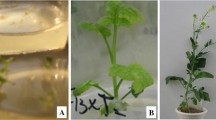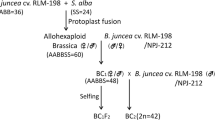Abstract
Five asymmetric hybrid plants were obtained between Medicago sativa (2n = 4x = 32) and Medicago arborea (2n = 4x = 32) through sexual reproduction and the use of a cytoplasmically male sterile M. sativa genotype. Over 2,000 pollinations were made to obtain these hybrids. Amplified fragment length polymorphism (AFLP) analysis showed that in the most studied hybrid (WA2273), 4% of the bands unique to the M. arborea parent were present, versus 72% for the unique M. sativa bands. This suggests that only a single M. arborea chromosome or chromosome parts has been transferred. WA2273 had 7% of AFLP bands which were not present in either parent, which is suggestive of chromosome rearrangements as would be expected if only chromosome parts or a single part had been transferred from M. arborea. Phenotypic evidence for hybridity was obtained for pod coiling (1.4 coils in WA2273 versus three coils in the M. sativa parent and its self and testcross populations, and one coil in M. arborea), and Colletotrichum trifolii race 2 resistance (transferred from the resistant M. arborea parent, as the M. sativa parent and the self populations were highly susceptible). The hybrids were self sterile, but were female fertile to a high level when crossed with 4x, but not 2x, M. sativa, indicating they were at or near 4x. Both the pod coiling trait and anthracnose resistance segregated in the progeny of testcrosses between WA2273 and M. sativa. The work demonstrates that agronomically useful traits can be introgressed into M. sativa from M. arborea by use of male sterile M. sativa and sexual reproduction.

Similar content being viewed by others
References
Baker KF (1957) The UC system for producing healthy container grown plants. Californian Agriculture Experimental Station Manual 23, 73
Barnes DK (1972) A system for visually classifying alfalfa flower colour. USDA agriculture handbook no. 424. ARS, USDA, Beltsville
Bena G, Prosperi JM, Lejeune B, Olivieri I (1998) Evolution of annual species of the genus Medicago: a molecular phylogenetic approach. Mol Phylogenet Evol 9:552–559
Bingham ET (1968) Aneuploids in seedling populations of tetraploid alfalfa Medicago sativa L. Crop Sci 8:571–574
Bingham ET (2005) Medicago arborea Project at University of Wisconsin. Medicago genetic reports, vol 5, pp 1–7. http://www.medicago-reports.org, Accessed 14 Dec 2007
Bingham ET, McCoy (1979) Cultivated alfalfa at the diploid level: origin, reproductive stability and yield of seed and forage. Crop Sci 19:97–100
Bingham ET, Haas T, Irwin J, Mackie J, Musial J, Armour D, Scotti C, Arcioni S, Jimenez C, Mauriera I (2006) Alfalfa says hello to the genome of Medicago arborea. Poster presented at 40th North American alfalfa improvement conference, 16–19 July 2006, Bloomington
Boyes JW, Thompson WP (1937) The development of the endosperm and embryo in reciprocal crosses in cereals. J Genet Breed 34:203–227
Camadro EL, Carputo D, Peloquin SJ (2004) Substitutes for genome differentiation in tuber-bearing Solanum; interspecific pollen–pistil incompatibility, nuclear-cytoplasmic male sterility, and endosperm. Theor Appl Genet 109:1369–1376
Elgin JH, Ostazeski SA (1982) Evaluation of selected alfalfa cultivars and related Medicago species for resistance to race-1 and race-2 anthracnose. Crop Sci 22:39–42
Elgin JH Jr, Ostazeski SA (1985) Inheritance of resistance to race-1 and race-2 anthracnose in Arc and Saranac AR alfalfa. Crop Sci 25:861–865
Fridriksson S, Bolton JL (1963) Development of the embryo of Medicago sativa L after normal fertilisation and after pollination by other species of Medicago. Can J Bot 41:23–33
Gaeta RT, Pires JC, Iniguez-Luy F, Leon E, Osborn TC (2007) Genomic changes in resynthesized Brassica napus and their effect on gene expression and phenotype. Plant Cell 19:3403–3417
Hendry GW (1923) Alfalfa in history. J Am Soc Agron 15:171–176
Irwin JAG, Lloyd DL, Lowe KF (2001) Lucerne biology and genetic improvement—an analysis of past activities and future goals in Australia. Aust J Agric Res 52:699–712
Irwin JAG, Aitken KS, Mackie JM, Musial JM (2006) Genetic improvement of lucerne for anthracnose (Colletotrichum trifolii) resistance. Aust Plant Pathol 35:573–579
Johnston SA, Hanneman RE (1980) Support of the endosperm balance number hypothesis utilizing some tuber-bearing Solanum species. Am Potato J 57:7–14
Kaimori N, Senda M, Ishikawa R, Akada S, Harada T, Niizeki M (1998) Asymmetric somatic cell hybrids between alfalfa and Bridsfoot trefoil. Breed Sci 48:29–34
Kidwell KK, Austin DF, Osborn TC (1994) RFLP evaluation of nine Medicago accessions representing the original germplasm sources for North American alfalfa cultivars. Crop Sci 34:230–236
Lefi E, Gulias J, Cifre J, Bin-Younes M, Medrano H (2004a) Drought effects on the dynamics of leaf production and senescence in field-grown Medicago arborea and Medicago citrina. Ann Appl Biol 144:169–176
Lefi E, Medrano H, Cifre J (2004b) Water use dynamics, photosynthesis and water use efficiency in field-grown Medicago arborea and Medicago citrina under prolonged Mediterranean drought conditions. Ann Appl Biol 144:299–307
Lesins K, Gillies CB (1972) Taxonomy and cytogenetics of Medicago. In: Hanson CH (ed) Alfalfa science and technology. Agronomy (Madison), vol 15, pp 53–86
Lesins K, Lesins I (1979) Genus Medicago (Leguminosae), a taxonomic study. Dr W Jurk. The Hague, The Netherlands
Mackie JM, Irwin JAG (1998) Genetics and race variability of the lucerne-Colletotrichum trifolii pathosystem in Australia. Aust J Agric Res 49:713–722
Mackie JM, Pepper PM, Lowe KF, Musial JM, Irwin JAG (2005) Potential to increase yield in lucerne (Medicago sativa subsp. sativa) through introgression of Medicago sativa subsp. falcata into Australian adapted material. Aust J Agric Res 56:1365–1372
Mackie JM, Musial JM, Armour DJ, Phan HTT, Elwood SE, Aitken KS, Irwin JAG (2007) Identification of QTL for reaction to three races of Colletotrichum trifolii and further analysis of inheritance of resistance in autotetraploid lucerne. Theor Appl Genet 114:1417–1426
McCoy TJ, Quarisa GH (1989) Allotetraploid behaviour of hybrids of Medicago sativa L and Medicago papillosa. Bioss Genome 32:6–11
McCoy TJ, Smith LY (1986) Interspecific hybrids of perennial Medicago species using ovule–embryo culture. Theor Appl Genet 71:772–783
Michaud R, Lehman WF, Rumbaugh MD (1988) World distribution and historical development. In: Hanson AA, Barnes DK, Hill RR (eds) Alfalfa and alfalfa improvement. Agronomy monograph 29. American Society of Agronomy, Crop Science Society of America, Soil Science Society of America, Madison, pp 25–91
Mizukami Y, Kato M, Takamizo T, Kanbe M, Inami S, Hattori K (2006) Interspecific hybrids between Medicago sativa L. and annual Medicago containing Alfafa weevil resistance. Plant Cell Tissue Organ Cult 84:80–89
Musial JM, Basford KE, Irwin JAG (2002) Analysis of genetic diversity within Australian lucerne cultivars and implications for future genetic improvement. Aust J Agric Res 53:629–636
Musial JM, Mackie JM, Armour DJ, Phan HTT, Elwood SE, Aitken KS, Irwin JAG (2007) Identification of QTL for resistance and susceptibility to Stagonospora meliloti in autotetraploid lucerne. Theor Appl Genet 114:1427–1435
Nenz E, Pupilli F, Damiani F, Arcioni S (1996) Somatic hybrid plants between the forage legumes Medicago sativa L. and Medicago arborea L. Theor Appl Genet 93:183–189
Pfeiffer TW, Bingham ET (1983) Abnormal meiosis in alfalfa, Medicago sativa: cytology of 2n egg and 4n pollen formation. Can J Genet Cytol 25:107–112
Small E, Jomphe M (1988) A synopsis of the genus Medicago (Leguminosae). Can J Bot 67:3260–3294
Song K, Lu P, Tang K, Osborn TC (1995) Rapid genome change in synthetic polyploids of brassica and its implications for polyploid evolution. Proc Natl Sci USA 92:7719–7723
Valentine DH (1956) Studies in British primulas. V. The inheritance of seed compatibility. New Phytol 55:305–318
Acknowledgments
Funding for the research was provided by the Grains Research and Development Corporation, Cooperative Research Centre for Tropical Plant Protection and The University of Queensland. All of this support is gratefully acknowledged.
Author information
Authors and Affiliations
Corresponding author
Additional information
Communicated by C. Gebhardt.
Rights and permissions
About this article
Cite this article
Armour, D.J., Mackie, J.M., Musial, J.M. et al. Transfer of anthracnose resistance and pod coiling traits from Medicago arborea to M. sativa by sexual reproduction. Theor Appl Genet 117, 149–156 (2008). https://doi.org/10.1007/s00122-008-0761-z
Received:
Accepted:
Published:
Issue Date:
DOI: https://doi.org/10.1007/s00122-008-0761-z




